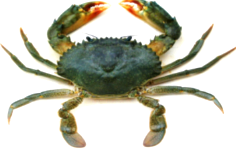- Mud crabs always in great demand for local consumption and live mud crab export trade
- Larger species of mud crab (Scylla tranquebarica) known to attain a maximum size of 2.4kg
- Sizable foreign exchange earning by export of live mud crabs
MUD CRAB FATTENING – WHY?
Weak and less weight water crabs (recently moulted) not accepted in export trade.
Rearing of water crabs for 3-4 weeks : An easy ideal operation with less financial inputs and an alternative livelihood for coastal fisher folks. |
 |
FATTENING IN CAGES / PENS / FENCED EARTHEN PONDS
- Fiberglass cages
- Plastic coated G.I wire mesh pen fixed in open brackishwater
- Earthen ponds with nylon net fencing
- Water crabs reared on trash fish / pelleted feed for 3-4 weeks to gain weight
|
   |
INVOLVEMENT OF CRAB FARMERS AND SELF HELP GROUPS (SHGs)
- Tie-up – Supply of water crabs by export companies and fattening by crab farmers / SHGs
|
   |
ANNUAL NET PROFIT
- Rs 7000/- from one cage with 9 compartments
- Rs 24,000/- from 100 m2 pen
- Rs 22,000/- from 100 m2 pond
|
|
TRAINING AND AWARNESS
- In-house /field training to farmers and SHGs
|
   |

